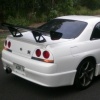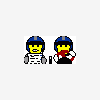Engine Assembly Question....
Announcements
-
Similar Content
-
Latest Posts
-
By joshuaho96 · Posted
I would not replace the gauges. A well setup tune should never require any of that. I'm of the opinion that if you can't safely hand over a car to your parents to drive it's not fit for purpose and more engineering work should be done. Honestly I'm not a fan of external boost controller boxes either but if you have to you can shove the controller into the glovebox or something once it's set up. Tee it off the OEM MAP sensor. Also you probably want to put a two pin plug on the new solenoid, bolting it to the OEM location works. Just separate the wastegate line and compressor outlet so it will work on a 3 port solenoid, kevboost was walked through how to do this on an RB26, same idea just different locations on an RB25. You may have to remove the restrictor in the OEM hoses if they're still in there. -
Yep, it's why in Australia we never brought in the 1 child policy like China. China can't afford to use the shit they make in their own country as it's too much to risk having only one child... Or maybe that's how they test their shit before they send it to Australia - they use the second kid that families had when they weren't supposed to as the tester? They weren't supposed to exist in the first place so no loss if they succumb to a work place incident? 🤣
-
It's also the reason neither Duncan or I can own a car rotisserie
-
By Looney_Head · Posted
this is the reason we have more than one child right? -
By DraftySquash · Posted
It was roughly 3.5 hours. car went in around 11:00 and I was done around 2:30 He did the initial runs, install the BC and then Nistune install and tune. The best part was sitting in the lobby and hearing the skyline on full throttle at the dyno 😂😂
-







Recommended Posts
Create an account or sign in to comment
You need to be a member in order to leave a comment
Create an account
Sign up for a new account in our community. It's easy!
Register a new accountSign in
Already have an account? Sign in here.
Sign In Now